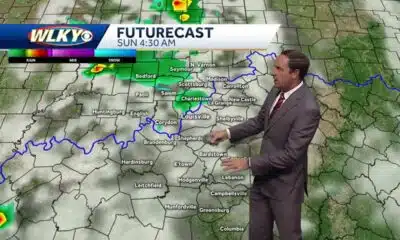News from the South - Louisiana News Feed
Sen. Bill Cassidy is in obvious damage-control mode ahead of Louisiana’s 2026 election cycle • Louisiana Illuminator
Sen. Bill Cassidy is in obvious damage-control mode ahead of Louisiana’s 2026 election cycle
by Greg LaRose, Louisiana Illuminator
February 9, 2025
It’s been almost four years since U.S. Sen. Bill Cassidy cast the political dice and diverted from Republican group think. He dared to endorse the impeachment of then-recently replaced President Donald Trump for his incitement of the Jan. 6 insurrectionist attack on the Capitol.
“Our Constitution and our country is more important than any one person. I voted to convict President Trump because he is guilty,” Cassidy said at the time.
Now Louisiana’s senior senator finds himself an unfavored incumbent, although a well-funded one, among hardcore GOP types ahead of his 2026 reelection bid. Despite an otherwise consistent track record of backing Trump’s favored causes and legislation, the impeachment vote was a bridge too far for the MAGA faithful.
Seizing upon Cassidy’s vulnerability, Louisiana Treasurer John Fleming has said he will enter the Republican primary next year. State Sen. Blake Miguez, arguably Louisiana’s most effective gun rights advocate, appears to be positioning himself for the race as well.
As for Cassidy, his actions and statements as of late have the appearance of someone making multiple acts of contrition with hopes they put him back in the good graces of Trumpian Republicans.
GET THE MORNING HEADLINES.
Most notable among his tail-tucking as of late was Cassidy’s swing vote to keep anti-vaccine advocate and conspiracy theorist Robert F. Kennedy on the path to become the next leader of the U.S. Department of Health and Human Services. Despite the Louisiana physician’s deep-rooted differences with Kennedy, Cassidy said he was able to reach a compromise that ensured the federal government’s vaccine approval framework would stay in place. Kennedy also vowed not to remove language from the health agency’s website that debunks his refuted claims that vaccines have been linked to autism, according to news reports.
But of course if Kennedy were to go back on his word – something the Trump administration has already demonstrated it’s comfortable doing – Cassidy would face great political peril were he to call out the hypocrisy.
This week, the senator made another gesture to win favor with the pro-Trump crowd. As one of the dozen Senate GOP co-sponsors of the newly reintroduced Supporting Made in America Energy Act, Cassidy wants the federal government to hold more lease sales in the top oil and gas producing states and in the federal offshore waters of the Gulf of Mexico and Alaska’s Cook Inlet.
“When we unleash American energy, we are supporting our allies, keeping Louisianans employed, and strengthening our economy. This bill will help us do that,” Cassidy said Friday in a statement.
Unfortunately, there are some holes in Cassidy’s reasoning – and not the kind that lead to oil and gas.
The Trump-led Department of Interior could open every leasable inch of federal land and water to “drill, baby, drill.” But it won’t necessarily trigger exploration from oil and gas companies. If anything, greater access to energy commodities will bring prices down, which is not in the best interest of their profit-geared business models. Their appetite for leasing depends on the energy markets and, for the sector’s publicly traded corporations, the ability to gain return on investments for their shareholders.
Such drilling decisions are more forward-looking, rather than motivated by the current price of gasoline at the pump or monthly heating oil bills. Plus, global influences and political instability have a way of crumbling even the most reliable industry experts’ forecasts.
For the leasing legislation from Cassidy and Co. to produce exploration activity that’s significant enough to bear political fruit, it would likely mean prices for crude oil are edging close to $100 per barrel. Closer to home, that scenario probably includes a sizable bite out of your wallet anytime you’ll fill up your fuel tank, pay your electric bill or buy anything with a price that reflects transportation costs (hello, groceries).
You can understand why Cassidy needs to align himself with the Trump agenda as next year’s election draws closer. But it doesn’t necessarily mean the strategy will pay off, either with a win for the senator or policy success for the president.
YOU MAKE OUR WORK POSSIBLE.
Louisiana Illuminator is part of States Newsroom, a nonprofit news network supported by grants and a coalition of donors as a 501c(3) public charity. Louisiana Illuminator maintains editorial independence. Contact Editor Greg LaRose for questions: info@lailluminator.com.
News from the South - Louisiana News Feed
Haynes wanted in on Wildlife bribery scheme too, informant says
SUMMARY: Dusty Guidry, a former consultant who pleaded guilty to accepting $800,000 in bribes, testified that Assistant District Attorney Gary Haynes sought involvement in a bribery scheme at the Louisiana Department of Wildlife & Fisheries. Haynes, on trial for conspiracy, bribery, money laundering, and obstruction, was previously appointed to run Lafayette’s pretrial diversion program after supporting DA Don Landry. Guidry revealed Haynes pressured him to include him in a similar diversion program scheme at Wildlife & Fisheries, receiving checks totaling $90,000. The scheme involved splitting bribes among Guidry, vendor Leonard Franques, and former department secretary Jack Montoucet, who has also been charged. The statewide program never launched.
Read the full article
The post Haynes wanted in on Wildlife bribery scheme too, informant says appeared first on thecurrentla.com
News from the South - Louisiana News Feed
OPPJ Comprehensive Plan
SUMMARY: The Ouachita Parish Police Jury is conducting a series of community meetings to gather public input for their comprehensive plan guiding future growth. Police Jury members, including Larry Bratton from District D, emphasize the importance of reflecting residents’ voices in the master plan. Community members participated in interactive stations, allocating resources to priorities like infrastructure and downtown development, to help shape goals for the next 2, 5, and 20 years. Landscape architect Matt Pizatella and partners from Atlas support the effort. Bratton stresses that without proactive planning, the parish risks costly and less beneficial outcomes in the long term.
OPPJ Comprehensive Plan
News from the South - Louisiana News Feed
Mayor Cantrell pleads not guilty to federal corruption charges; judge imposes travel restrictions
SUMMARY: Mayor Latoya Cantrell pleaded not guilty to 11 federal charges including conspiracy, fraud, obstruction, and making false statements. The indictment links an alleged affair with her police bodyguard, Officer Vappy, to misuse of city funds and efforts to conceal deleted encrypted WhatsApp messages. Although no personal financial benefit is claimed, the charges accuse Cantrell of arranging unnecessary protective details for Vappy, costing taxpayers $70,000. Released without bond, Cantrell must surrender her passport, requires approval for travel outside Louisiana, and is barred from discussing the case with city employees or Vappy. Despite restrictions, court rules her ability to manage city operations remains unaffected.
Cantrell was indicted by a grand jury Aug. 15 as additional charges tacked onto Vappie’s indictment from 2024.
-
News from the South - North Carolina News Feed6 days ago
Reagan era credit pumps billions into North Carolina housing | North Carolina
-
News from the South - Kentucky News Feed6 days ago
3 states push to put the Ten Commandments back in school – banking on new guidance at the Supreme Court
-
News from the South - South Carolina News Feed6 days ago
South Carolina’s Tess Ferm Wins Miss America’s Teen 2026
-
News from the South - Alabama News Feed6 days ago
Amid opposition to Blount County medical waste facility, a mysterious Facebook page weighs in
-
News from the South - West Virginia News Feed7 days ago
National Grandparents Day (9-7-25) and the special bond shared with their grandchildren
-
Local News6 days ago
Duke University pilot project examining pros and cons of using artificial intelligence in college
-
News from the South - Arkansas News Feed5 days ago
‘One Pill Can Kill’ program aims to reduce opioid drug overdose
-
Local News7 days ago
Marsquakes indicate a solid core for the red planet, just like Earth








































